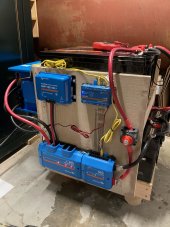Steve_S
Offgrid Cabineer, N.E. Ontario, Canada
There are so many opinions and minutia.I've been digging through the forum and I'm seeing multiple posts about how batteries wired in parallel should have identical length wires between them.
Please have a look at this PDF from Victron Systems who "know" what they are doing and do explain things nicely.
Specificaly refer to Page 18 "3.3 Parallel battery bank wiring" and forward.
This is one of a few subjects which can easily invoke the proverbial "Beating of the dead horse".





